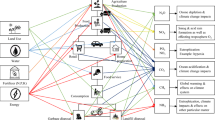Abstract
Aim
Each year, about 48 million people in the United States are affected by foodborne illnesses, with approximately 3000 of these cases resulting in death. In Texas, the incidence of illnesses like campylobacteriosis and salmonellosis has increased since 2015. In Lubbock County, Texas, however, published data on foodborne illness are scarce. The purpose of this study was to describe trends in foodborne illness in Lubbock and other counties in Texas and to evaluate the potential role of environmental inspector shortages on foodborne illnesses in Lubbock.
Subjects and methods
County-level infectious disease cases were obtained from the Texas Department of State Health Services (DSHS) for the years 2005 and 2016–2018 and were further categorized into food-based and non-food-based. Odds ratios for the association between public health region and cases of foodborne illness over time were estimated using logistic regression. A qualitative framework analysis of environmental health inspector interview responses was conducted.
Results
Region 1 had the highest odds of foodborne illness cases among all regions. In Lubbock, an inverse relationship was observed between the number of environmental inspectors and cases of foodborne illness, with an increase in inspectors from six to nine over the period of 2016–2018 associated with a decreasing trend in the cumulative incidence of foodborne illnesses.
Conclusion
The increase in the number of inspectors in the city of Lubbock could be a factor in decreasing the incidence of foodborne illnesses, as their work is vital to ensuring adequate food safety practices.




Similar content being viewed by others
References
Centers for Disease Control and Prevention (2018) CDC and Food Safety. Retrieved from https://www.cdc.gov/foodsafety/cdc-and-food-safety.html
Centers for Disease Control and Prevention, National Center for Emerging and Zoonotic Infectious Diseases (NCEZID) (2019) Foodborne Illnesses and Germs. Retrieved from https://www.cdc.gov/foodsafety/foodborne-germs.html
City of Lubbock, Texas, Health Department (2020) Environmental Health. Retrieved from https://ci.lubbock.tx.us/departments/environmental-health
IBM Corp. Released (2019) IBM SPSS statistics for windows, version 26.0. IBM Corp, Armonk, NY
Jones TF, Pavlin BI, LaFleur BJ et al (2004) Restaurant inspection scores and foodborne disease. Emerg Infect Dis 10(4):688–692
Lund BM, O'Brien SJ (2011) The occurrence and prevention of foodborne disease in vulnerable people. Foodborne Pathog Dis 8(9):961–973
Switaj TL, Winter KJ, Christensen S (2015) Diagnosis and Management of Foodborne Illness. Am Fam Physician 92(5):358–365
Texas Department of State Health Services (2019a) Campylobacteriosis. Retrieved from https://www.dshs.state.tx.us/DCU/disease/Campylobacteriosis.aspx
Texas Department of State Health Services (2019b) Salmonellosis. Retrieved from https://dshs.texas.gov/IDCU/disease/Salmonellosis.aspx
van den Hombergh P, Künzi B, Elwyn G et al (2009) High workload and job stress are associated with lower practice performance in general practice: an observational study in 239 general practices in the Netherlands. BMC Health Serv Res 9:118
Acknowledgements
Thank you to Mrs. Katherine Wells, MPH (Director of the Lubbock City Health Department), for her support and guidance throughout this study. A special thanks as well to the environmental health inspectors for agreeing to be interviewed for this study.
Author information
Authors and Affiliations
Contributions
All authors contributed to the study conception and design. Material preparation, data collection, analysis, and revisions were performed by Obadeh Shabaneh, Mark Walker, Theresa Byrd, and Duke Appiah. The first draft of the manuscript was written by Obadeh Shabaneh, and all authors commented on previous versions of the manuscript. All authors read and approved the final manuscript.
Corresponding author
Ethics declarations
Conflict of interest
The authors declare that they have no conflict of interest.
Financial disclosures
None reported.
Ethics approval
This is an observational study. The local ethics committee of Texas Tech University Health Sciences Center has confirmed that no ethical approval is required.
Additional information
Publisher’s note
Springer Nature remains neutral with regard to jurisdictional claims in published maps and institutional affiliations.
Electronic supplementary material
ESM 1
(DOCX 13 kb)
Rights and permissions
About this article
Cite this article
Shabaneh, O., Walker, M.S., Byrd, T. et al. Investigating trends in foodborne illnesses in Lubbock and other counties in Texas. J Public Health (Berl.) 30, 695–699 (2022). https://doi.org/10.1007/s10389-020-01349-1
Received:
Accepted:
Published:
Issue Date:
DOI: https://doi.org/10.1007/s10389-020-01349-1




